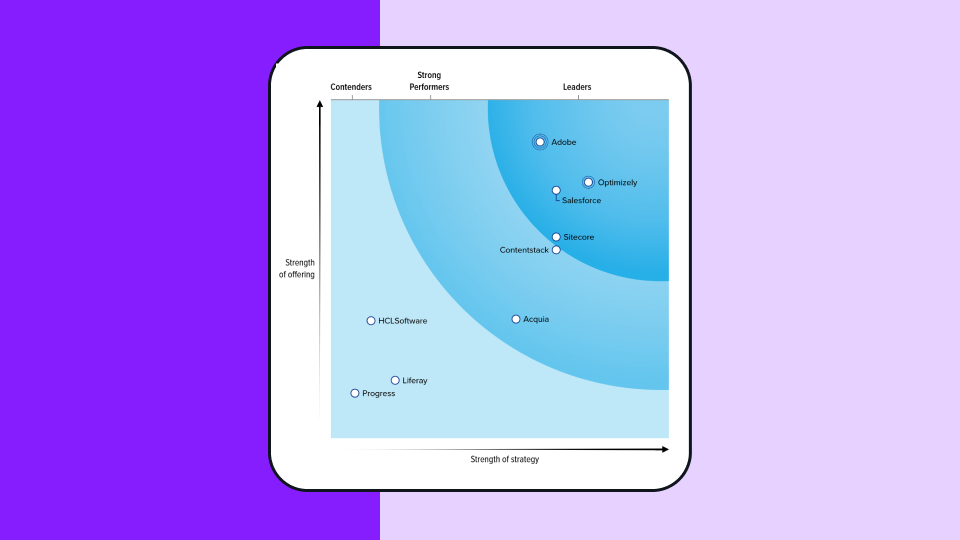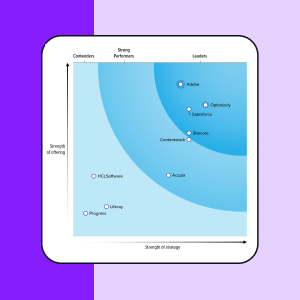Agile CMS
What is Agile CMS?
Agile content management systems, or agile CMS refers to a new style of headless CMS focused on content development, creative collaboration, decision transparency and omnichannel delivery.
Agile CMS has evolved in the context of increasing customer expectations for seamless, cross-channel experiences and flawless functionality. Like the management method from which it takes its name, agile CMS facilitates responsive content development and delivery -- responsive to customer expectations and mobile design needs. As a result, agile CMS is fast becoming a crucial tool for creating personalized, seamless and omnichannel customer experiences.
Read on to learn how an agile CMS:
-
Differs from other CMSs
-
Boosts content development and marketing collaboration
-
Provides robust and future-proof omnichannel deployment options
-
Boosts customer experience (CX) and helps personalize the customer journey
What exactly is meant by agile?
Agile CMS is not officially a new category of CMS like "traditional," "legacy" or "headless" CMS. It represents an innovative iteration of headless CMS designed around content flexibility and customer experience. Agile CMS is tailored to content and marketing teams working in agile content development settings. Often agile CMS is incorporated as a critical component within cloud-based digital experience platforms (DXP).
You need to understand what "agile" means for developers and content creators before the idea of an agile CMS will make sense.
The origins of agile development
A group of software development CEOs and innovators all met in Utah in 2001 for a meeting. Most were from competing companies, but they all shared one common belief. Rigid, un-organic development processes were detrimental to creativity, output quality, employees and clients.
The participants published a 12-statement Agile Manifesto that launched a new way to lead and manage software development centered on downsizing significant development problems into the smallest, most incremental tasks possible. It also emphasized flexibility and adaptability to focus on ever-changing and unpredictable client needs.
Agile CMS for content management and customer experience development
The agile philosophy quickly spread to other service enterprises -- including marketing content development and customer journey design.
Agile content management requires:
- Communication: Clear directives and feedback among all team stakeholders and with the client.
- Chunking: Breaking problems and tasks down into the smallest components allows for flexibility in reverse engineering or changing circumstances.
- Collaboration: Openness and diverse input from all team members.
- Iteration: Continual progress and improvement toward an end goal -- which may change as well during the iterative process.
All four of the above characteristics go beyond what a typical headless CMS can offer. These traits are baked into the best agile CMS packages.
The four agile CMS differentiators
According to a 2021 comprehensive study conducted on agile CMS platforms, Forrester Research noted four key areas where the best agile CMS platforms differ from all others.
-
User-centered content hub
All CMSs have a back-end content hub. However, in agile CMS, the content hub is specifically designed with the end-user, in this case business users, in mind -- i.e., your content creation, marketing, sales, and project management teams. The hub allows everyone to find, access and administer all of your company's content including the latest versions, updated in real-time.
-
Built-in planning and real-time collaboration tools
Agile methodology is all about project planning and continuous collaboration, feedback and iteration. The best agile CMS packages come with built-in tools to facilitate this digitally.
Collaboration and feedback are fully baked into the CMS. Project planning tools allow everyone to see where different "slices" or phases of different project components are in the production cycle. Managers can easily discover project areas that are falling behind or require more resources to complete on time. All stakeholders can view everything of pertinence with no secrets or surprises.
-
Content service flexibility
Like all CMSs, agile can deliver content to various existing channels, but unlike the others, it's not beholden to specific channels such as responsive websites. Agile CMS embraces the miniaturization aspect of the agile method. Your teams create content in minimal, chunked formats. Marketers and content creators may repurpose and mash up these content chunks to create new or personalized content for customers in the future.
Not only is your content marketing usable today for delivery on the mobile web, but it's created and stored in a manner making it deployable tomorrow in an augmented-reality Google Map. In other words, your content is more than omnichannel-ready. It's future-proof, regardless of medium.
-
Advanced development platform fits in any existing technology stack
Agile CMS is not exclusive. It's built to integrate into any company's existing development stack. The best systems are cloud-based, accessible via the web. APIs allow you to integrate an agile API into your CRM and delivery software workflows. The leading agile CMS packages, such as Forrester Research's highly ranked Optimizely CMS, can be integrated within a larger customer experience software suite or a digital experience platform (DXP). Coupling agile content creation with data-driven customer experience software is a proven way to increase customer satisfaction and ROI.
The agile CMS advantage
Agile CMS allows your agile-managed projects to be delivered, updated and chunked as designed. The CMS remains headless, but it's built to allow for project miniaturization, data-based iteration, cross-team collaboration, current deployments and future channel content delivery. Some of the advantages of agile CMS include:
Stakeholder collaboration and planning
Time to tear down those silos. The first step to implementing a successful agile CMS is to organize your teams in a collaborative, agile manner. If you're already agile, you're a step ahead. If not, consider making the push to agile organization and project management today.
Content chunking for maximum personalization and omnichannel delivery
Agile is now used almost everywhere, from project management to curriculum design. Agile aims to do one thing above all else regardless of where or how it's implemented: break a problem down into a series of minuscule, discrete tasks. It delivers the ability to miniaturize, chunk creative content and create content.
Customer experience-driven content delivery
Agile CMS centralizes all of your content in chunked, modular form. Your marketers can now use customer experience data to pick-and-choose which personalized content to present to customers. Making a sale is about making the right pitch to the right person in the right place, and at the right time. Personalization and targeted pitches are easier than ever to create with an agile CMS anchoring your marketing team.
Implement agile CMS into your company's workflow
If you find your current traditional or headless CMS is no longer working for your company, consider making the move to a cloud-based agile CMS. It's flexible, collaborative and focused on content creators and managers instead of developers.
Agile CMS works well on its own, but it works even better with other cloud-based customer experience tools. Agile CMS gives your marketing teams more flexibility and control over your brand's content, now and in the future.

